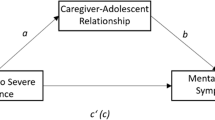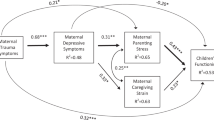Abstract
Youth with perinatally acquired HIV (PHIV) are at risk for depressive symptoms, which are associated with a range of adverse outcomes. Although family contextual factors associated with depressive symptoms differ among boys and girls without PHIV, it is unclear whether this is also the case among youth with PHIV. Participants included 314 youth with PHIV (M = 12.88, SD = 3.08 years old; 51% male; 85% Black/Latinx) and their caregivers. Higher levels of caregivers’ own depressive symptoms, caregiver-child detachment, and family conflict were associated with higher levels of caregiver-reported youth depressive symptoms. Less consistent discipline was associated with higher levels of youth-reported depressive symptoms. Higher youth-reported depressive symptoms were associated with greater family cohesion among boys and greater caregiver detachment among girls. Consideration of contextual variables is essential for interventions for depressive symptoms among youth with PHIV, but attention to sex differences with family contextual factors is also important.


Similar content being viewed by others
References
Mellins CA, Brackis-Cott E, Leu CS, et al. Rates and types of psychiatric disorders in perinatally human immunodeficiency virus-infected youth and seroreverters. J Child Psychol Psychiatr. 2009;50:1131–8.
Mellins CA, Malee KM. Understanding the mental health of youth living with perinatal HIV infection: lessons learned and current challenges. J Int AIDS Soc. 2013;16:1–19.
Spudich S. HIV as neurocognitive dysfunction. Curr HIV/AIDS Rep. 2013;10:235–43.
Agwu AL, Fairlie L. Antiretroviral treatment, management challenges and outcomes in perinatally HIV-infected adolescents. J Int AIDS Soc. 2013;16:18579.
Gadow KD, Chernoff M, Williams PL, et al. Co-occurring psychiatric symptoms in children perinatally infected with HIV and peer comparison sample. J Dev Behav Pediatr. 2010;31:116–28.
Bhana A, Mellins CA, Small L, et al. Resilience in perinatal HIV+ adolescents in South Africa. AIDS Care. 2016;28:49–59.
Gaughan DM, Hughes MD, Oleske JM, Malee K, Gore CA, Nachman S. Psychiatric hospitalizations among children and youths with human immunodeficiency virus infection. Pediatrics. 2004;113:e544–e551551.
Kang E, Mellins CA, Ng WYK, Robinson LG, Abrams EJ. Standing between two worlds in Harlem: a developmental psychopathology perspective of perinatally acquired human immunodeficiency virus and adolescence. J Appl Dev Psychol. 2008;29:227–37.
Elkington KS, Robbins RN, Bauermeister JA, Abrams EJ, McKay M, Mellins CA. Mental health in youth infected with and affected by HIV: the role of caregiver HIV. J Pediatr Psychol. 2011;2011(36):360–73.
Gadow KD, Angelidou K, Chernoff M, et al. Longitudinal study of emerging mental health concerns in youth perinatally infected with HIV and peer comparisons. J Dev Behav Pediatr. 2012;33:456–68.
Williams PL, Storm D, Montepiedra G, et al. Predictors of adherence to antiretroviral medications in children and adolescents with HIV infection. Pediatr. 2006;118:e1745–e17571757.
Sander JB, McCarty CA. Youth depression in the family context: Familial risk factors and models of treatment. Clin Child Fam Psychol Rev. 2005;8:203–19.
Yap MBH, Pilkington PD, Ryan SM, Jorm AF. Parental factors associated with depression and anxiety in young people: a systematic review and meta-analysis. J Affect Disord. 2014;156:8–23.
Repetti RL, Taylor SE, Seeman TE. Risky families: family social environments and the mental and physical health of offspring. Psychol Bull. 2002;128:330–66.
Restifo K, Bögels S. Family processes in the development of youth depression: translating the evidence to treatment. Clin Psychol Rev. 2009;29:294–316.
Dutra R, Forehand R, Armistead L, et al. Child resiliency in inner-city families affected by HIV: the role of family variables. Behav Res Therapy. 2000;38:471–86.
Mellins CA, Brackis-Cott E, Dolezal C, Leu CS, Valentin C, Meyer-Bahlburg HFL. Mental health of early adolescents from high-risk neighborhoods: the role of maternal HIV and other contextual, self-regulation, and family factors. J Pediatr Psychol. 2008;33:1065–75.
Antle BJ, Wells LM, Goldie RS, DeMatteo D, King SM. Challenges of parenting for families living with HIV/AIDS. Soc Work. 2001;46:159–69.
Pequegnat W. Family and HIV/AIDS: first line of health promotion and disease prevention. In: Pequegnat W, Bell CC, editors. Family and HIV/AIDS. New York: Springer; 2012. p. 3–45.
Malee KM, Tassiopoulos K, Huo Y, et al. Mental health functioning among children and adolescents with perinatal HIV infection and perinatal HIV exposure. AIDS Care. 2011;23:1533–44.
Eberhart NK, Shih JH, Hammen CL, Brennan PA. Understanding the sex difference in vulnerability to adolescent depression: an examination of child and parent characteristics. J Abnorm Child Psychol. 2006;34:493–506.
Hankin BL. Development of sex differences in depressive and co-occurring anxious symptoms during adolescence: descriptive trajectories and potential explanations in a multiwave prospective study. J Clin Child Adol Psychol. 2009;38:460–72.
Paus T, Keshavan M, Giedd JN. Why do many psychiatric disorders emerge during adolescence? Nat Rev Neurosci. 2008;9:947–57.
Nolen-Hoeksema S, Hilt LM. The emergence of gender differences in depression in adolescence. In: Nolen-Hoeksema S, Hilt LM, editors. Handbook of Depression in Adolescents. New York: Routledge; 2013. p. 127–152.
Davies PT, Lindsay LL. Interparental conflict and adolescent adjustment: Why does gender moderate early adolescent vulnerability? J Fam Psychol. 2004;18:160–70.
Krause ED, Vélez CE, Woo R, et al. Rumination, depression, and gender in early adolescence: a longitudinal study of a bidirectional model. J Early Adolesc. 2017;38:923–46.
Chan GCK, Kelly AB, Toumbourou JW. Accounting for the association of family conflict and very young adolescent female alcohol use: the role of depressed mood. J Stud Alcohol Drugs. 2013;74:396–505.
Unger DG, Brown MB, Tressell PA, McLeod LE. Interparental conflict and adolescent depressed mood: the role of family functioning. Child Psychiatry Hum Dev. 2000;31:23–41.
Davies PT, Windle M. Gender-specific pathways between maternal depressive symptoms, family discord, and adolescent adjustment. Dev Psychol. 1997;33:657–68.
Atkinson ER, Dadds MR, Chipuer H, Dawe S. Threat is a multidimensional construct: exploring the role of children’s threat appraisals in the relationship between interparental conflict and child adjustment. J Abnorm Child Psychol. 2009;37:281–92.
Cui M, Donnellan MB, Conger RD. Reciprocal influences between parents’ marital problems and adolescent internalizing and externalizing behavior. Dev Psychol. 2007;2007(43):1544–52.
Kelly AB, Mason WA, Chmelka MB, et al. Depressed mood during early to middle adolescence: a bi-national longitudinal study of the unique impact of family conflict. J Youth Adolesc. 2016;45:1604–13.
De Los Reyes A, Augenstein TM, Wang M, et al. The validity of multi-informant approach to assessing child and adolescent mental health. Psychol Bull. 2015;141:858–900.
van den Heuvel LL, Levin J, Mpango RS, et al. Agreement and discrepancy on emotional and behavioral problems between caregivers and HIV-infected children and adolescents from Uganda. Front Psychiatry. 2019;10:460.
Drabick DAG, Gadow KD, Loney J. Co-occurring ODD and GAD symptom groups: Source-specific syndromes and cross-informant comorbidity. J Clin Child Adolesc Psychol. 2008;37:314–26.
Hyde JS, Mezulis AH, Abramson LY. The ABCs of depression: Integrating affective, biological, and cognitive models to explain the emergence of the gender difference in depression. Psychol Rev. 2008;115:291–313.
Williams PL, Chernoff M, Angelidou K, et al. Participation and retention of youth with perinatal HIV infection in mental health research studies: the IMPAACT P1055 Psychiatric Comorbidity Study. J Acquir Immune Defic Syndr. 2013;63:401–9.
Nachman S, Chernoff M, Williams P, Hodge J, Heston J, Gadow KD. Human immunodeficiency virus disease severity, psychiatric symptoms, and functional outcomes in perinatally infected youth. Arch Pediatr Adolesc Med. 2012;166:528–35.
Williams PL, Leister E, Chernoff M, et al. Substance use and its association with psychiatric symptoms in perinatally HIV-infected and HIV-affected adolescents. AIDS Behav. 2010;14:1072–82.
Gadow KD, Sprafkin J. Child and Adolescent Symptom Inventory-4R. Stony Brook, NY: Checkmate Plus; 2005.
Gadow KD, Sprafkin J. Youth’s Inventory-4 Manual. Stony Brook, NY: Checkmate Plus; 1999.
Gadow KD, Sprafkin J. Child Symptom Inventory-4 Screening and Norms Manual. Stony Brook, NY: Checkmate Plus; 2002.
Gadow KD, Sprafkin J, Carlson GA, et al. A DSM-IV-referenced, adolescent self-report rating scale. J Am Acad Child Adolesc Psychiatry. 2002;41:671–9.
Gadow KD, Sprafkin J. Adolescent Symptom Inventory-4 Screening and Norms Manual. Stony Brook, NY: Checkmate Plus; 2008.
Drabick DAG, Gadow KD, Sprafkin J. Co-occurrence of conduct disorder and depression in a clinic-based sample of boys with ADHD. J Child Psychol Psychiatry. 2006;2006(47):766–74.
Dibble E, Cohen DJ. Companion instruments for measuring children's competence and parental style. Arch Gen Psychiatry. 1974;30:805–15.
Atzaba-Poria N, Pike A, Deater-Deckard K. Do risk factors for problem behaviour act in a cumulative manner? An examination of ethnic minority and majority children through an ecological perspective. J Child Psychol Psychiatry. 2004;45:707–18.
Moos RH, Moos BS. Family Environment Scale Manual. 3rd ed. Palo Alto, CA: Consulting Psychologists Press; 1994.
Boyd CP, Gullone E, Needleman GL, Burt T. The family environment scale: reliability and normative data for an adolescent sample. Fam Proc. 1997;36:369–73.
Sanford K, Bingham CR, Zucker RA. Validity issues with the family environment scale: psychometric resolution and research application with alcoholic families. Psychol Assess. 1999;11:315–25.
Gadow K, Sprafkin J, Weiss M. Manual for the Adult Self-report Inventory and Adult Symptom Inventory. Stony Brook, NY: Checkmate Plus; 2004.
Muthén LK, Muthén BO. Mplus User’s Guide (8th ed.). Los Angeles, CA: Muthén & Muthén, 1998–2017.
Graham JW. Missing data analysis: making it work in the real world. Annu Rev Psychol. 2009;60:549–76.
Newman DA. Longitudinal modeling with randomly and systematically missing data: a simulation of ad hoc, maximum likelihood, and multiple imputation techniques. Organ Res Methods. 2003;6:328–62.
Aiken LS, West SG. Multiple Regression: Testing and Interpreting Interactions. Thousand Oaks, CA: Sage; 1991.
Holmbeck GN. Post-hoc probing of significant moderational and mediational effects in studies of pediatric populations. J Pediatr Psychol. 2002;27:87–96.
Mahoney JL, Schweder AE, Stattin H. Structured after-school activities as a moderator of depressed mood for adolescents with detached relations to their parents. J Comm Psychol. 2002;30:69–866.
Gross HE, Shaw DS, Burwell RA, Nagin DS. Transactional processes in child disruptive behavior and maternal depression: a longitudinal study from early childhood to adolescence. Dev Psychopathol. 2009;21:139–56.
Gotlib IH, Krasnoperova E, Yue DN, Joormann J. Attentional biases for negative interpersonal stimuli in clinical depression. J Abnorm Psychol. 2004;113:127.
Freeman MC, Patel V, Collins PY, Bertolote JM. Integrating mental health in global initiatives for HIV/AIDS. Br J Psychiatry. 2005;187:1–3.
McKay M, Block M, Mellins C, et al. Adapting a family-based HIV prevention program for HIV-infected preadolescents and their families: Youth, families and health care providers coming together to address complex needs. Soc Work Ment Health. 2007;5:355–78.
Acknowledgments
Overall support for the International Maternal Pediatric Adolescent AIDS Clinical Trials Network (IMPAACT) was provided by the National Institute of Allergy and Infectious Diseases (NIAID) of the National Institutes of Health (NIH) under Award Numbers UM1AI068632 (IMPAACT LOC), UM1AI068616 (IMPAACT SDMC), and UM1AI106716 (IMPAACT LC), with co-funding from the Eunice Kennedy Shriver National Institute of Child Health and Human Development (NICHD) and the National Institute of Mental Health (NIMH). The content is solely the responsibility of the authors and does not necessarily represent the official views of the NIH.
Author information
Authors and Affiliations
Corresponding author
Additional information
Publisher's Note
Springer Nature remains neutral with regard to jurisdictional claims in published maps and institutional affiliations.
Rights and permissions
About this article
Cite this article
Drabick, D.A.G., Jakubovic, R., Myerberg, L. et al. Family Contextual Factors are Differentially Associated with Depressive Symptoms among Boys and Girls with Perinatally Acquired HIV. AIDS Behav 25, 259–268 (2021). https://doi.org/10.1007/s10461-020-02966-3
Published:
Issue Date:
DOI: https://doi.org/10.1007/s10461-020-02966-3




